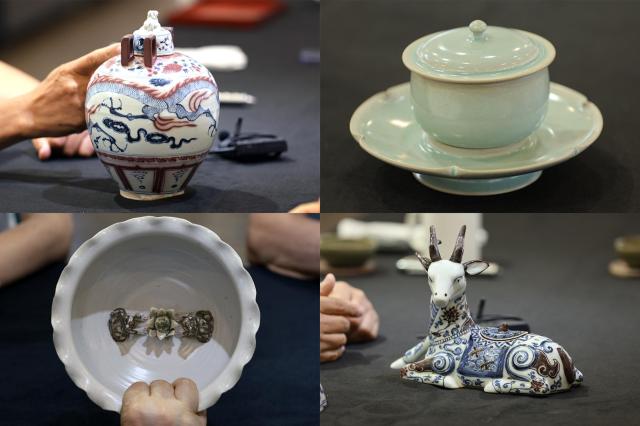
SEOUL, July 11 (AJP) - During the expert appraisal event held on July 8 (Tuesday) and 9 at Daboseong Gallery in Gyeonun-dong, Jongno-gu, Seoul, a new selection of previously unpublished Chinese relics believed to have been used by members of the imperial family or aristocracy was unveiled.
◆ Ru ware celadon-glazed vase with gilt-rimmed mouth from the Northern Song Dynasty (北宋汝窑天青釉金口纸槌瓶)
This Ru ware celadon-glazed vase from the Northern Song period (960 to 1127) is one of the few surviving examples from Ru kilns, one of the five great kilns of the era. With its narrow, elongated neck, angular shoulders, and flat base, the vase resembles the shape of a paper mallet. Hence the name "paper mallet vase" (zhichui ping). The mouth is accented with a layer of gilt. Its refined form and gilded rim suggest it was used by members of the royal family or aristocracy.
The entire surface is coated in a sky-blue celadon glaze (tianqingyou), creating a soft, luminous tone with rich depth. Delicate crackle patterns, or crazing, naturally formed on the surface. Ru ware was produced exclusively by imperial order during the reign of Emperor Huizong. It is extremely rare, making it a highly valued artifact.
◆ Lidded jar with blue-and-white underglaze red cloud and dragon chasing pearl motif from the late Yuan to early Ming period (元末明初 青花釉里红云龙戏珠纹有盖壶)
This lidded jar features a dynamic image of a three-clawed dragon flying through auspicious clouds, chasing a flaming pearl surrounded by fiery waves.
The sides of the lid are adorned with plum blossom branches. The top is fitted with a bold animal-shaped handle. A rod-like decorative element appears to pierce through the lid, and three loops attached to the shoulder allow the lid to be secured. These features add to the vessel’s uniqueness. The jar’s rare lid shape, elaborate adornments, harmonious proportions, and majestic dragon motif suggest it was likely used by emperors or aristocrats.
◆ Ru ware covered tea or wine cup with lotus-shaped saucer from the Northern Song Dynasty (北宋汝窑盖盏及花形托)
This artifact consists of a lidded cup and lotus-petal-shaped saucer, produced at the Ru kilns during the Northern Song period. Believed to have been used for tea or wine offerings, it displays the classic elegance of Ru ware. It has refined proportions, soft celadon glaze, and fine surface crazing.
The exterior is covered in a light bluish-green glaze, with naturally formed crackles spreading across the surface. This creates a tranquil beauty and sense of depth. The faintly glowing glaze reveals the finely prepared clay body beneath, showcasing Ru ware’s high-temperature firing technique and purified material quality. As a rare complete set reflecting royal taste, this piece is thought to have served as a funerary item for imperial or noble families.
◆ Blue-and-white incense burner in the shape of a deer with iron-painted details from the Ming Xuande period (明宣德青花铁绘鹿形香炉)
This deer-shaped porcelain incense burner was produced during the Xuande reign of the Ming Dynasty (1426 to 1435). It demonstrates the harmony of blue-and-white and iron-painted decoration. A small lidded opening with a handle is set on the deer’s back, allowing incense to be placed inside. When in use, the smoke emerges from the deer’s nose, mouth, and back. This enhances both the practical function of the incense burner and its sculptural form.
Notably, this piece has been preserved in its entirety. It is believed to have been used as a funerary item for royalty or aristocracy. In Chinese culture, the word for deer (lu) is a homonym for lu, meaning official salary or emolument. It symbolizes wealth and high status. When paired with depictions of immortals or the elixir of life, the deer also becomes a symbol of longevity.
◆ Ding ware bowl with lotus petal rim and molded frog and lotus motif from the Northern Song Dynasty (北宋定窑贴花荷叶口大碗)
This large bowl from the Ding kilns of the Northern Song Dynasty is a fine example of high-quality white porcelain. Its striking shape and intricate molded decorations immediately attract attention. The bowl’s rim is formed in the wavy mouth (boshuangkou) style, a classic Chinese ceramic form with evenly spaced undulating curves.
The most notable feature is the interior decoration at the bottom. It includes two frogs and a lotus blossom. In Chinese symbolism, the lotus stands for purity and the frog represents fertility. These motifs reflect the aesthetic preferences of Song-era aristocrats. This bowl exemplifies the elegance of Song white porcelain. With its rare wave-shaped mouth and depiction of a lotus pond scene inside, it is considered a unique court or noble artifact. No comparable examples have been discovered to date.
Copyright ⓒ Aju Press All rights reserved.



